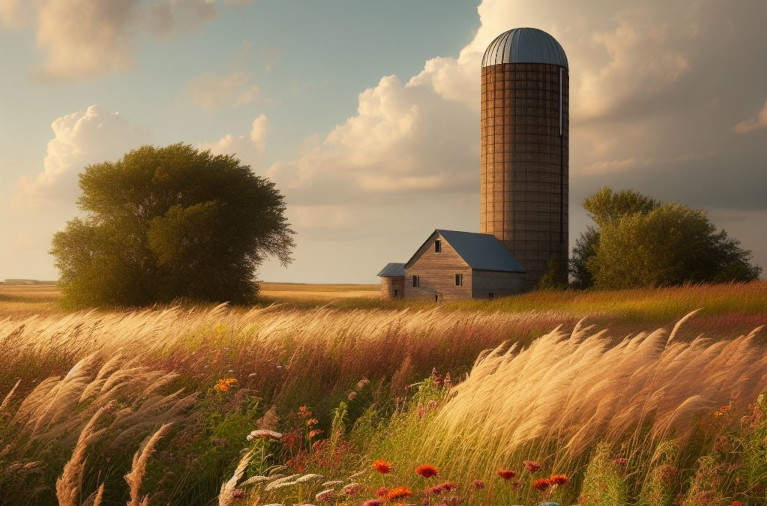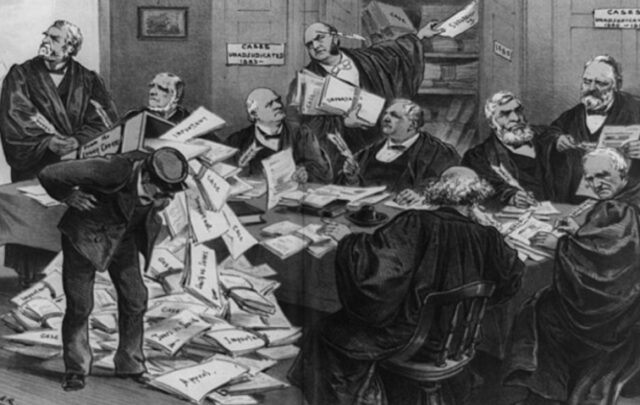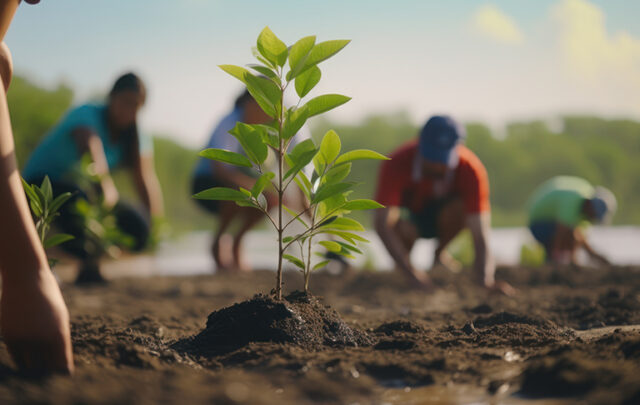Picture a natural prairie, boasting an explosive diversity of grasses and flowers. Every year, at different times of the year, the grasses and flowers produce seeds. Some of these seeds, naturally, propagate their respective species so that the grasses and flowers will survive into the next year and the next.
But the plants are generous, generating more seeds than are necessary. Being the only form of life on the prairie capable of harvesting solar energy and turning it into food, they know they have sole responsibility for supporting their entire community. And why would they want to share their wealth? Well, they rely on insects for pollination, fungi for trading nutrients, worms for turning the soil, birds for spreading seeds far and wide, mice for planting their seeds and providing rich fertilizer, and on and on. Open-ended generosity pays back via other gifts in a spirit of reciprocity.
The mice in the prairie have done well for countless generations. While they are capable of explosive reproduction, they can’t expand willy nilly because food resources are limited: if they overgraze, fewer plants will survive into the following year. Meanwhile, hawks, owls, foxes and snakes are always looking for a snack. And so the prairie has settled on a roughly stable mouse population that works in concert with the rest of the ecological community. The population of mice (and of their predators) is not rock-solid: it fluctuates from year to year, but seldom strays very far before self-correcting. When mice are few, their predators diminish, seed abundance goes up, and the stage is set for a resurgence.
Then one day a foraging mouse notices a new hole at the base of an abandoned silo on the edge of the prairie that’s been dormant and irrelevant for all these years. Out of this hole some grains of wheat have spilled out. Tasty! Excited by her find, she brings her friends and they all have a feast. Within weeks, the mice are growing in number and exploiting this seemingly endless resource. All troubles would appear to be over.
Generation after generation comes and goes as the mouse population continues to swell and underground cities of tunnels blossom. An elaborate transport system from the silo to their tunnels allows them to escape predation: no more nosing about on the surface looking for seeds under the eyes of a hungry hawk.
The mouse population is unimaginably larger than it ever could have been under the prairie’s sustainable support, and the mice congratulate themselves on their smarts and good looks. What an innovative species to transcend the boring rules of the obsolete past in a bold defiance of limits! Celebrations shift away from focusing on nature’s gifts and cycles—onto mouse birthdays, mouse marriages, mouse accomplishments, and famous mouses.
The prairie, however, is not faring so well. Extensive tunneling has damaged roots, leading to a sickly show up top. Altered soil chemistry from all the pooping further impacts the health of the plants. The hawks, owls, foxes and snakes starve, dwindle, and vanish one by one like falling dominoes. So, not only are the prairie plants in trouble, the rest of the community is collapsing as the mice practice their destruction and no longer seem to need all those gifts from the prairie.
But no matter: the grain is all the mice need, and mice are all that matters. Long live the Mouse Reich!
You see where this is going, right? We know that the silo does not hold an infinite amount of grain. It never did. The exuberant extravaganza of the mice is of finite duration. Anyone could have seen it coming. But the mice, by-and-large, chose not to look. Why question what is clearly an amazingly good situation?
Compounding the tragedy is that the prairie is so ruined by the grain-fed imbalance that it can no longer even support the original population of mice that it could before the grain silo came into the picture. The carrying capacity has been reduced by relentless pressures caused by the mice.
As the mice take stock of their situation, they see a dizzying world of problems. Extensive damage to roots and vegetation caused by tunneling means that rains now produce erosion and tunnel flooding in a way that healthy soils did not allow. Higher population densities have led to more frequent disease, and other ills that are suspected to stem from spending all their time below ground and having a “processed” diet. Waste accumulation has overwhelmed the absorptive capacity of the prairie, while simultaneously destroying that very capacity via decline of microbial soil health, atrophy of fungal networks, and die-off of the plants that once absorbed nutrients. Lack of vegetation results in less shade and evaporative cooling from leaves, making their world increasingly hotter and unsuitable for life. Social unrest is high, because their world is filling up, and concentrated wealth from the silo inevitably fostered inequality in a way that was completely unknown in the days of prairie life.
How do the mice react to the “poly-crisis?” Some dismiss it: things have never been better, and the march of improvement will obviously continue. Most acknowledge that some things are messed up, but have faith that a few innovations and tweaks can solve the problems—because this lifestyle is clearly the way things are meant to be. Many implicitly prioritize maintaining the sophisticated “urban” complex of tunnels and associated way of life, by alternate means if possible. The modern way having lasted for several generations, virtually none have any experience outside of the current aberrant way of life. Few see beyond their noses and have not learned to value the broader community of life—which simply hasn’t figured into tunnel life. Their narrow focus allows the broader degradation to mount—ignored in plain sight.
Attention centers on technological solutions to their source of energy (food): replacing the silo provisions with a substitute that won’t run out—no matter the impact to the land or destruction of intact prairies elsewhere to provide enough land base to keep going. Besides the fact that no one can show such a scheme to be viable in the long term (because it can’t be), what if their prairie was the only one, surrounded by empty, barren space?
What the mice have lost is context. They no longer see themselves as evolved animals that once played a role within a diverse and interconnected community of life. Unwittingly, by allowing the temporary availability of “free” resources to substitute for robust ecological flows, they damaged the ecological foundation, creating the ultimate mouse trap. They got it in their heads that they could go it alone: conjure anything they needed at the collateral expense of who-cares-how-many species. Nothing else mattered: their accomplishments and infrastructure carried more market value than the natural world on which they would ultimately depend again. Pride in their marvelous chainsaw blinded them to the fact that they were using it to cut the branch they stood upon.
They were lured into a false sense that technology can substitute ecology. Why on Earth would this new arrangement be expected to work in the long term? It’s such a dramatic and untested departure from the deeply interconnected community that worked before, painstakingly honed by eons of evolution. Echoing a 1980s cereal slogan (for Kix), the way they lived before was time-tested, evolution-approved. How could they possibly expect to thrive while the web of life around them fragmented and dissolved?
Even those who acknowledge the poly-crisis miss a key truth: it’s a meta-crisis. All the identified problems that constitute the “poly” stem from a single “meta.” The attitude of separateness from the community of life, the sense of superiority over other species, and self-praise over artificial accomplishment is what allowed the ugly profusion of poly problems. Those problems cannot be solved under the flawed mindset that led to the predicament in the first place.
How will the mice adapt to a new reality? Almost certainly in mixed form: those who cling to the familiar will go down with the ship, as it were. Those who are adventurous enough to try new ways are not guaranteed to succeed, but the ones who do succeed will be the ones who abandon the problematic ways and seek a healthier, humbler connection with what remains of the crippled community of life—striving to heal together.
Modern Mouse
As was no doubt evident all along, almost every sentence above can be ported to the human–modernity predicament—substituting planet for prairie, for instance. I don’t need to belabor the comparisons, other than to point out that we were all once, too, part of a complex ecological community of life, each species playing an interactive role. Many humans veered off the path when we began storing grain ourselves—thousands of years ago. Fossil fuels, aided by science and technology, became our analog to the silo on the prairie (though we were already way off track). We transformed the way we fed people, replacing natural spaces with artificial environments to plant, fertilize, and harvest crops so that we might feed an ever-growing population while rooting out competition and potential predators. It looks like a war on nature. But like the grain silo, the present bonanza cannot last. Many focus on replacing fossil fuel with alternative energy, but this does nothing to mitigate the root problems of ecological destruction—in fact only powering their continuance. At this point, ecological health has been degraded to the extent that the vibrant community of life that existed before this whole episode began is teetering on termination and is no longer capable of supporting what it once could.
A failing of the mouse story as an analog to modernity is the temptation it may foster to force a one-to-one mapping of the silo onto fossil fuels, while in fact the silo represents much more than just that. Human cultures had already stepped very far from the evolutionary contract well before the recent introduction to fossil fuels, stretching back to the beginning of grain agriculture. Civilization has flirted with unsustainability ever since—now in its final, global act.
Modernity is not time-tested, evolution-approved. It will fail. The question becomes: how do we respond to the failure? Should we cling like mad to modernity and let the failure escalate to even greater violence? Or should we encourage the bold among us to arrange a quiet, early exit to start exploring new ways to live?





